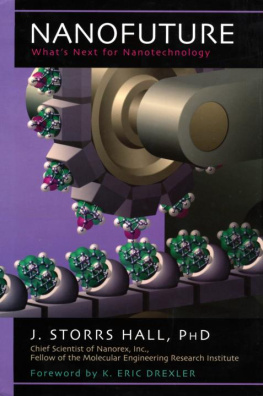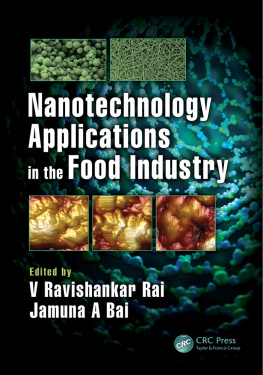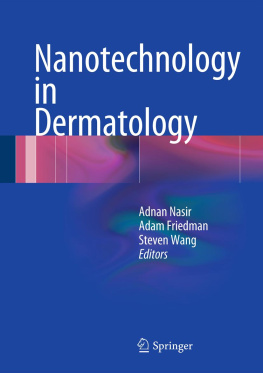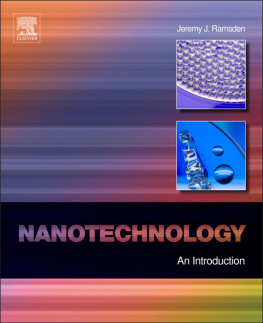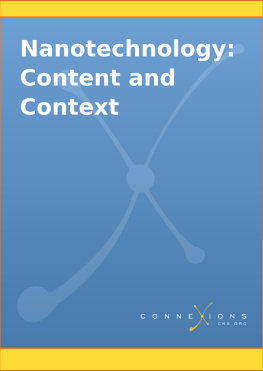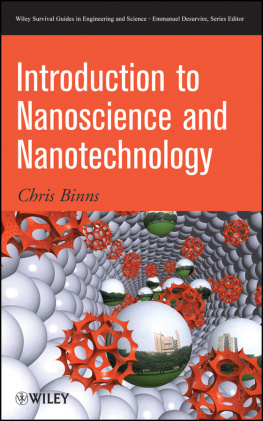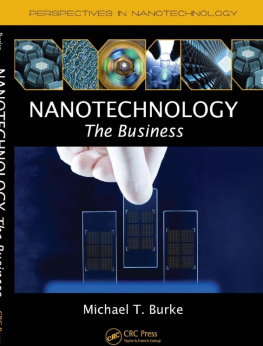Table of Contents
Pages
Guide
List of Illustrations
- Chapter 1: Introduction
- Chapter 2: Nanomaterials: General Synthetic Approaches
- Chapter 3: Characterization Tools for Nanomaterials
- Chapter 4: Nanomaterials
- Chapter 5: Carbon-Based Nanomaterials
- Chapter 6: Self-Assembled and Supramolecular Nanomaterials
- Chapter 7: Nanocomposites
- Chapter 8: Unique Properties
- Chapter 9: Applications of Nanotechnology
- Chapter 10: Toxicity and Environmental Issues
List of Tables
- Chapter 1: Introduction
- Chapter 2: Nanomaterials: General Synthetic Approaches
- Chapter 3: Characterization Tools for Nanomaterials
- Chapter 4: Nanomaterials
- Chapter 5: Carbon-Based Nanomaterials
- Chapter 6: Self-Assembled and Supramolecular Nanomaterials
- Chapter 7: Nanocomposites
- Chapter 8: Unique Properties
- Chapter 9: Applications of Nanotechnology
- Chapter 10: Toxicity and Environmental Issues
Essentials in Nanoscience and Nanotechnology
Narendra Kumar
Sunita Kumbhat
Copyright 2016 by John Wiley & Sons, Inc. All rights reserved
Published by John Wiley & Sons, Inc., Hoboken, New Jersey
Published simultaneously in Canada
No part of this publication may be reproduced, stored in a retrieval system, or transmitted in any form or by any means, electronic, mechanical, photocopying, recording, scanning, or otherwise, except as permitted under Section 107 or 108 of the 1976 United States Copyright Act, without either the prior written permission of the Publisher, or authorization through payment of the appropriate per-copy fee to the Copyright Clearance Center, Inc., 222 Rosewood Drive, Danvers, MA 01923, (978) 750-8400, fax (978) 750-4470, or on the web at www.copyright.com. Requests to the Publisher for permission should be addressed to the Permissions Department, John Wiley & Sons, Inc., 111 River Street, Hoboken, NJ 07030, (201) 748-6011, fax (201) 748-6008, or online at http://www.wiley.com/go/permissions.
Limit of Liability/Disclaimer of Warranty: While the publisher and author have used their best efforts in preparing this book, they make no representations or warranties with respect to the accuracy or completeness of the contents of this book and specifically disclaim any implied warranties of merchantability or fitness for a particular purpose. No warranty may be created or extended by sales representatives or written sales materials. The advice and strategies contained herein may not be suitable for your situation. You should consult with a professional where appropriate. Neither the publisher nor author shall be liable for any loss of profit or any other commercial damages, including but not limited to special, incidental, consequential, or other damages.
For general information on our other products and services or for technical support, please contact our Customer Care Department within the United States at (800) 762-2974, outside the United States at (317) 572-3993 or fax (317) 572-4002.
Wiley also publishes its books in a variety of electronic formats. Some content that appears in print may not be available in electronic formats. For more information about Wiley products, visit our web site at www.wiley.com.
Library of Congress Cataloging-in-Publication Data:
Names: Kumar, Narendra (Materials scientist), author. | Kumbhat, Sunita, author.
Title: Essentials in nanoscience and nanotechnology / Narendra Kumar, Sunita Kumbhat.
Description: Hoboken, New Jersey : John Wiley & Sons, Inc. 2016. | Includes bibliographical references and index.
Identifiers: LCCN 2015040306 | ISBN 9781119096115 (cloth)
Subjects: LCSH: Nanotechnology. | Nanoscience.
Classification: LCC T174.7 .K78 2016 | DDC 500dc23 LC record available at http://lccn.loc.gov/2015040306
Preface
The turn of twenty-first century has witnessed the emergence of three cutting-edge technologies, namely, Information and Communication Technology (ICT), Biotechnology, and Nanotechnology. In 2005, the United Nations Task Force on the Millennium Development Goals touted Nanotechnology as one of three platform technologies that can reduce hunger, promote health, improve water sanitation, develop renewable resources, and improve the environment, and recommended that developing countries should initiate nanotechnology programs at a national level. Inspired by such forecasts, by 2014, over 60 countries followed the United States and established the National Nanotechnology Initiative. These countries range from advanced industrial countries in Europe and Japan to the emerging markets of Russia, China, Brazil, and India.
Physicist Richard Feynman, in his famous speech of 1959, forecasted the development of nanoscience and the punch line plenty of room at the bottom became reality by the 1980s when scientists developed techniques and tools to explore and manipulate matter at the atomic scale. The term nanoscale defines a size range from 1 to 100 nm, although a scientifically based range goes from the atomic scale (0.2 nm) to 100 nm. The focus on the nanoregime relates to the convenience of some standard definition that can be used to both categorize nanotechnology, nanoscience, and nanoproducts and act as a bridge between quantum mechanical effects and surface area effects.
Nanoscience is not merely about size; it is about the unique physical, chemical, biological, and optical properties that emerge naturally at the nanoscale, whereas nanotechnology is related to the ability to manipulate and engineer such effects. It is a broad new area of science that demolishes boundaries among physics, chemistry, biology, cognitive science, materials science, and engineering at the nanoscale. New technologies, however, are likely to revolutionize the economy and the society only if there is a broader strong National base consisting of trained manpower and infrastructure that allows a new technology to spread and transform to its exciting niche applications, whether civilian or military. To do so, the most important thing is to educate and train the budding manpower at the school and university levels. For that, availability of standard books is necessary, and this book is designed keeping in mind these essential requirements.
Furthermore, keeping in view the unprecedented research and development in the area of nanoscience and nanotechnology and to make the students aware about the latest developments in the field, we have attempted to write this book in a manner as simple as possible while including the latest development in the field. The subject matter of the book, ranging from fundamentals to the latest developments and technological applications, is presented in 10 chapters. The first chapter on introduction gives a historical prospective, provides living examples of nanoscience in nature and artificial nanomaterials, and brings out the likely impact of nanotechnology on human civilization. are devoted to the unique properties and applications of nanotechnology in various disciplines such as information technology, pollution, environment, energy, healthcare, consumer goods, and so on. Finally, the last chapter deals with the toxicological and ethical issues associated with nanotechnology.
We believe this book will generate and promote the basic understanding on the complex and revolutionary disciplines of nanoscience and nanotechnology, which is offered now as a core subject in most of the academic institutions across the globe.
Acknowledgments



